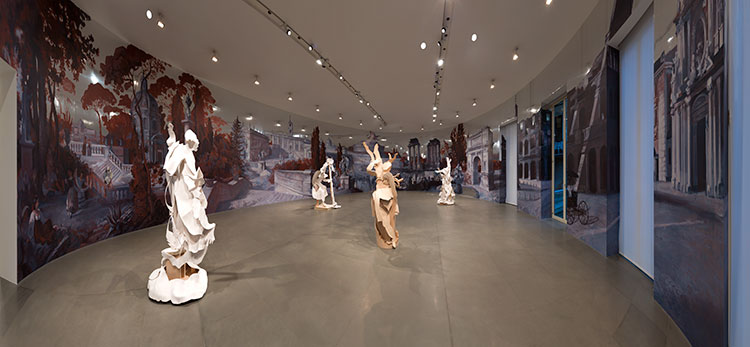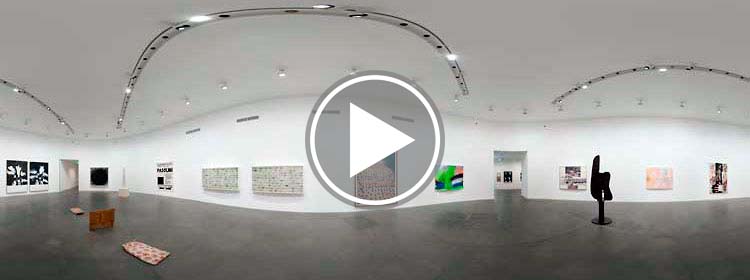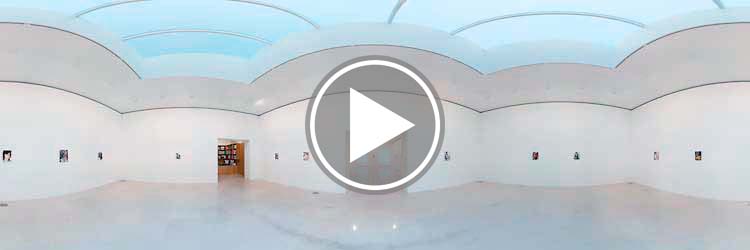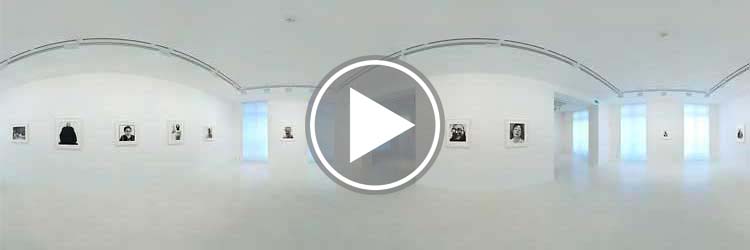| |
 |
GAGOSIAN GALLERY
Rome, Paris |
Italiano > |
 |
| |
ROME - Exhibition: RACHEL FEINSTEIN (Nov, 19 - 2012) >
| |
 |
| Click on image to open interactive panorama |
Rachel Feinstein
Rome 17 November 2012 – 5 January 2013
I’ll do a drawing, and then drawings of the drawing, and keep getting away from the source as
many times over as I can so I don’t just replicate. I’m not interested in trying to copy the object
itself. And then sometimes I’ll cut up the drawing and hot glue-gun the whole thing into a threedimensional
paper drawing, and either that will become a sculpture on its own—because that weird,
flattened, planed-wood sculpture will be really beautiful—or I’ll use that as a skeleton, and then I’ll
add stuff on top.
—Rachel Feinstein
Feinstein’s multi-part installations, which contain autonomous sculptures and paintings, reveal her
singular flair for synthesizing a myriad of cultural fascinations—religion, myth, beauty, mortality,
decadence—into vignettes of the marvelous. Oil paintings on mirrored surfaces, flat propped
sculptures reminiscent of stage dressings, and abstracted reworkings of classical sculpture confront
persistent issues of artistic representation such as theatricality and illusionism. By layering
quotations from diverse artistic, architectural, cultural, and stylistic sources—from religious
iconography to Baroque sculpture, Romantic landscapes, and popular cartoons—art and history are
charged with a burlesque sensibility.
In this latest of her compelling fantasies, Feinstein has covered the interior gallery walls with a
panoramic wallpaper of an impressionistic Rome. Sourcing and collaging diverse artistic visions of
the city from different historical periods, she first made a large oil painting on mirror depicting this
heterotopia of her own invention, where an eighteenth century piazza scene buzzing with life
jostles against ancient ruins and an Arcadian landscape. This was then printed on mirrored
wallpaper, to which five diamond-shaped glass mirrors, painted with faces, are fixed, merging
cunningly with the background panorama while catching and reflecting the passing viewer’s gaze.
Against this scenography stand four larger than lifesize sculptures, inspired by favorite depictions
of early Christian saints and martyrs. Working from small paper models, the designs are scaled up
into curved and spliced wooden elements and coated in pale monochrome resin. Their sketchy,
dynamic lines evoke the muscular Baroque aesthetic that dominates the Roman environment, but
without the volume or mass. There is the Archangel Michael, who vanquished Satan in a heavenly
war; Saint Agatha the virgin martyr and symbol of resistance, who survived numerous tortures for
her devout faith, most notably having her breasts cut off as punishment for rejecting the sexual
advances of a Roman prefect; Saint Sebastian, who miraculously survived being pierced with
arrows for his refusal to disavow his faith, only to be beaten to death later; and Saint Christopher,
the patron of travelers who bears the weight of the world upon his shoulders. Devoid of the
expressionistic detail of their famous agonies and ecstasies, the sculptures function like shadows in
the round, suggestive and yet remote from their original sources.
Rachel Feinstein was born in 1971 in Ft. Defiance, Arizona. She studied at Columbia University and
Skowhegan School of Painting and Sculpture. Her work has been the subject of numerous solo and
group exhibitions, including “The Alliance,” Hyundai Gallery, Beijing, China (2008, traveled to
Hyundai Gallery, Korea); “Something About Mary,” Metropolitan Opera House, New York (2009);
“Rachel Feinstein: The Snow Queen,” Lever House, New York (2011); and “The Little Black Dress,”
SCAD Museum of Art, Savannah, Georgia (2012). Feinstein lives and works in New York.
from Gagosian press release |
| |
|
|
| |
|
|
| |
ROME - Exhibition: MADE IN ITALY (July 4, 2011) >
| |
 |
| |
MADE IN ITALY
Rome, Friday 27 May – Friday 29 July, 2011
Say what ill of it you may; (Italy) still remains to the poet the land of his predilection, to the artist the land of his necessity, and to all the land of dreams and visions of delight. Henry W. Longfellow (1807 -1882)
The exhibition maps an unexpected Italian journey through works by seminal artists of the past sixty years:
Georg Baselitz, Jean Michel Basquiat, Joseph Beuys, Dike Blair, Marcel Duchamp, Alberto Giacometti, Douglas Gordon, Andreas Gursky, Damien Hirst, Howard Hodgkin, Mike Kelley, Jeff Koons, Louise Lawler, Roy Lichtenstein, Richard Prince, Robert Rauschenberg, Gerhard Richter, Richard Serra, Cindy Sherman, David Smith, Thomas Struth, Cy Twombly, Andy Warhol, and Lawrence Weiner.
The irresistible appeal of Italy for international artists is deeply rooted in history. In the tradition of the Grand Tour of the eighteenth and nineteenth centuries, British, American, French and German travelers crossed the Alps to witness what they had previously only experienced in books; the wonders of the classical tradition, the masterpieces of an idealized past, as well as the thrill that the distinct Italian lifestyle and customs kindled.
Immersing themselves in the marvels of the past and the harmonious disarray of the present, artists from near and far negotiated the trials and tribulations of early tourism. From Venice's Byzantine exoticism, the cerebral sensuality of the Florentine Renaissance, and the beguiling vestiges of classical Rome, Italy became an inspiring artistic idea and ideal. This infatuation continued into the twentieth century, during which tourism became easier and accessible to many.
The animated cities or pastoral idylls of Italy remain a rite of passage in the careers of many contemporary artists.
Three hundred years from the inception of this tradition, the Italian experience – from its unrivaled arthistorical wealth to the kaleidoscopic quality of daily life – has remained of vital relevance to modern and contemporary artistic production. The oeuvres of Leonardo da Vinci, Giorgio De Chirico, and Caravaggio have been interpreted by Marcel Duchamp, Andy Warhol, and Cindy Sherman while archeology has fuelled the imaginations of Roy Lichtenstein and Jean-Michel Basquiat; the totality of modern landscapes have been interpreted by Gerhard Richter and Andreas Gursky; Alberto Giacometti and Jeff Koons have treated the female canon while Joseph Beuys, Mike Kelley, and Richard Serra have been inspired by key cultural figures or episodes of the contemporary period.
'Italy, or rather, the many civilizations which emerged over the centuries in the cities and territories that we have come to call Italy, constitutes a unique example of historical and artistic cohesion', explains Mario Codognato, curator of the exhibition. 'This particularity has made it a point of reference, and of both attraction and conflict, for visual artists in the Western world.
Italy is past and present; archeology and contemporary creativity. Its two distinct identities conflate the weight of tradition with the contradictions of modernity.' With key works by some of the greatest modern and contemporary artists, Made in Italy will reconstruct the personal and creative journeys that brought them at specific moments in their careers into direct confrontation with this universal legacy called Italy.
Gagosian press release |
|
|
| |
|
|
| |
PARIS - Exhibition: Elisabeth Peyton (July 18, 2011) >
| |
 |
| |
ELISABETH PEYTON
Paris, May 27 - July 28, 2011
With the statement "A painter can say all he wants to with fruit, flowers or even clouds," Edouard Manet evoked the genre of still-life painting to rebuff the heroic and overcharged history paintings of his time.
More than a century later, Peyton's jewel-like paintings reaffirm Manet's belief in the quiet potency of an enduring intimiste genre.
Portraits of artists both historical and contemporary (Camille Claudel, Isa Genzken), some of whom are also Peyton's friends (Rirkrit, Klara, Hans-Ulrich), are rendered from photographs or from life. Peyton imbues each likeness with a startling freshness and immediacy, although like a still life it is distanced from its subject. She has recently begun to conflate the genre of portraiture, where the subject is subsumed into a field of pictorial elements, along with that of traditional still lifes, where she situates objects at hand in delicate fields of pattern and color with a clear identification of time and place, as in , Paris, 2010 and Flowers & Teapot, Berlin, 2010.
Although Peyton's paintings infer a deep knowledge of historical artistic forbears from Goya to Warhol, this awareness is processed through an instinctual understanding of the time in which she lives. Combining her insights with modest scale, a lush yet tremulous palette, and extreme graphic sensitivity, her paintings and drawings are testaments to a passion for beauty in all its forms, from the sublime to the everyday.
Elizabeth Peyton was born in Connecticut in 1965. She studied at the School of Visual Arts, New York. Her work is collected by leading museums including Musée national d'art moderne de la ville de Paris, Centre Georges Pompidou, Paris; Kunstmuseum, Wolfsburg; Museum für Gegenwartskunst, Basel; Museum of Fine Arts, Boston; Museum of Modern Art, New York; Whitney Museum of American Art, New York; San Francisco Museum of Modern Art; Seattle Art Museum; and Walker Art Center, Minneapolis. Recent solo exhibitions include "Live Forever", New Museum of Contemporary Art (2008, traveled to Walker Art Center, Minneapolis, Whitechapel Art Gallery, London, and Bonnefanten Museum, Maastricht, Holland in 2009); "Reading and Writing", Irish Museum of Modern Art (2009); "Wagner" at the Gallery Met, New York (2011) and "Ghost: Elizabeth Peyton," presented concurrently at the Mildred Lane Kemper Art Museum and the Opelvillen in Rüsselsheim, Germany (2011).
Peyton lives and works in New York and Berlin. |
|
|
| |
|
|
| |
PARIS - Exhibition: Richard Avedon , Writers (July 18, 2011) >
| |
 |
| |
RICHARD AVEDON, WRITERS
Paris, Jun 8 - Jul 28, 2011
During a career that spanned nearly sixty years, Richard Avedon defined and expanded concepts of art and culture in twentieth century photography while producing an extended meditation on life, death, beauty, class, race, and identity. His reportage, portrait and commercial work dissolved the lines between photography's many perceived genres, as it ranged across a breadth of subject matter including fashion, the American Civil Rights movement, war protestors, the fall of the Berlin wall, and portraits of the famous and the anonymous.
Larry Gagosian comments "Avedon is America's consummate modern photographer and one of the iconic artists from a generation which produced many extraordinary painters, sculptors, and photographers. We consider it a great privilege to represent one of the true masters of twentieth century art."
Richard Avedon established The Richard Avedon Foundation during his lifetime. The Foundation is the repository for Avedon's photographs, negatives, publications, papers, and archival materials. Paul Roth, the Executive Director of The Richard Avedon Foundation, comments, "We are delighted to work with Gagosian Gallery around the world. We think that Avedon will receive outstanding representation in the company of the many modern and contemporary masters exhibited here."
Richard Avedon (1923-2004) is regarded as one of the most influential artists of the 20th century. Born in New York City, Avedon began his professional photographic career in 1942 in the U.S. Merchant Marine Photographic Department, and attended the Design Laboratory at the New School. He began work as a fashion photographer for Harper's Bazaar in 1945, eventually joining rival Vogue magazine, where he would remain on staff until 1990. In 1992 he was named the first staff photographer for The New Yorker. He received a Master of Photography Award from the International Center for Photography and his work is included in the collections of MoMa, the Smithsonian, and Metropolitan Museum of Art, along with countless other museums and institutions worldwide. Avedon's portraits were the subject of an exhibition at the Metropolitan Museum of Art in 2002. A major 2007 retrospective exhibition organized by the Louisiana Museum of Modern Art in Denmark traveled to Milan, Paris, Berlin, Amsterdam and San Francisco. |
| |
|
|
| |
|
|
|
|
| |
|
|
| |
|
|
|

